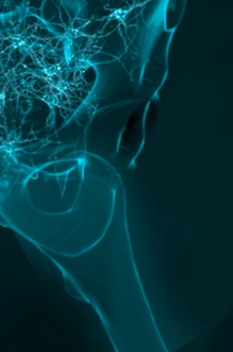Introduction
Peripheral nerve tumors can occur anywhere in the body. Most of them aren't cancerous ...
Injuries or irritation of the pelvic nerves
Chronic neuropathic pelvic pain disorders are pain syndromes that can result from damage to or irritation of the pelvic nerves. Typical pain is vulvodynia, coccygodynia, pudendal pain, sciatica and prostate pain. The pain can be localised easily, radiates into the buttocks, genital organs or legs and leads to malfunctions of the pelvic organs such as bladder, intestines and the reproductive organs. Since nerve pain is perceived as burning pain, it is particularly distressing for those affected. It is only a permanent solution for the of the origin of the pain that can bring about lasting relief.
Irritation of the pelvic nerves is the most common cause of neuropathic pelvic pain. In such cases, the nerves are not injured, they are merely compressed or constricted by external factors. The nerve function is not diminished, but rather it is increased. In addition to the pain, there is an intensified sensitivity of the skin surface or discomfort in the pain areas, such as tingling or burning. The functions of the pelvic organs are also increased. Bladder emptying is normal, but patients often have a strong urge to urinate or an overactive bladder.
In most cases, dilated veins ( varicose veins) - a condition known as "vascular pelvic entrapment" - are responsible for the compression of the pelvic nerves. If the pressure increases due to sitting or standing for a long time, for example, the pain worsens or the pelvic veins pulsate. Endometriosis or scar tissue (fibrotic entrapment) can also cause neuropathic pelvic pain. Scar tissue often develops after surgical intervention near the nerves or due to a postoperative hematoma.
Treatment with mesh or loop implantation in pelvic organ prolapse are procedures where patients are particularly at risk of fibrotic entrapment of the pelvic nerves. Nerve lesions caused by fibrotic tissue or vascular entrapment can develop over several months or even years.
Fix the cause of the pain: The laparoscopic relief of the nerves
While the drug therapy for chronic pelvic pain only alleviates the symptoms, the neuropelveological approach concentrates on the treatment of the cause of pain. Neuropelveology allows the surgeon to make an individual diagnosis and choose the appropriate medical or neurosurgical treatment. Laparoscopic nerve decompression is the most common type of treatment for pelvic nerve irritations, i.e. laparoscopic surgery.
Decompression surgery relieves the pressure on the nerves. All structures that constrict the affected nerve, such as endometriosis, existing scar tissue or mesh material, are removed laparoscopically, while the nerve itself remains intact. If dilated blood vessels are the cause of the nerve impairment, they are sclerosed (coagulated) and then severed to prevent further dilatation.
Laparoscopy is a safe and effective method of treating neuropathic pelvic pain. Access through the abdominal wall using a tiny camera allows diagnosis and treatment of the cause. Tumors that cause nerve compression must also be removed - preferably laparoscopically
Advanced therapy for nerve damage: nerve stimulation and the "LION procedure"
Surgical procedures can result in injuries due to blood coagulation, lack of blood supply (ischemia), cuts or sutures. These often lead to a loss of sensation, pain and dysfunction, which start immediately after the operation or a few days later. Endometriosis, rare pelvic tumours or primary diseases of the nerves themselves, such as multiple sclerosis, can also be the cause of nerve damage.
Neuropathic pain is accompanied by numbness in the buttocks, genital region or legs. Sometimes partial or complete loss of control over muscles or organ functions can result. Possible consequences include urinary retention, constipation, motor dysfunction and erectile dysfunction. Lastly, there may also be phantom pain as well.
If such nerve damage is present, laparoscopic release of the nerves is not sufficient in and of itself. Neuromodulation therapy - the implantation of electrodes that continuously stimulate the damaged nerve with electricity - is required. The procedure of choice for this operation is the "LION procedure" developed by Prof. Possover: microelectrodes (neuroprostheses) are placed laparoscopically, i.e. minimally invasively with the help of laparoscopy, near the damaged nerve. The aim of nerve stimulation is to eliminate pain and functional disorders of the organs.
To help people in difficult situations to improve their quality of life has become his life's passion. Continuous research, decades of clinical experience and the focused determination to find a solution for previously unsolved medical problems, have enabled Prof. Possover to help often quite discouraged patients find release from their seemingly insurmountable problems.
Our team will take care of you
We will dedicate our expertise and know-how to help you find the solution that is right for you.
„As a cheerful, open and communicative person, I really appreciate coming into contact with people from all over the world. The well-being of others is very important to me.“
If it is your preference, your attending doctor is welcome to accompany you to Zürich. You will then have a person at your side who is familiar with your medical concerns. At the same time, your doctor will have the opportunity to be present during the planned operation and gain unique insights into the applied practice of Neuropelveology.

Neuropelveology is a medical discipline developed by Prof. Possover. It is based on the discovery of the pelvic nerves and includes the diagnosis of the diseases of these nerves by means of gynaecological examination methods and their treatment by means of laparoscopy.
Read morePeripheral nerve tumors can occur anywhere in the body. Most of them aren't cancerous ...
Vulvodynia is a chronic pain syndrome affecting respectively the vulva and occurs ...
Klausstrasse 4
CH - 8008 Zürich
Switzerland
E-Mail: mail@possover.com
Tel.: +41 44 520 36 00